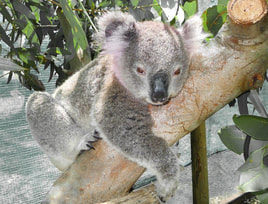|
KOALAS |
The koala (Phasclarctos Cinereusis) is related to the kangaroo and the koala's closest living relative is the wombat. Koala are listed as vulnerable to extinction in New South Wales. Only authorised and experiences persons with appropriate training, facilities and access to food trees, are permitted to handle Koalas.
|
Common Problems
Threats to koalas include:
|
What To Do
If you find a sick or injured Koala:
|
Koala Joeys
|
|
Symptoms of common ailments
|
More Information
|
Want to know more?
Koalas are (arguably) Australia's most iconic animal, known throughout the world. They are truly unique and have a special "cuteness" factor that sees them loved around the world. Yet here in NSW they are slowly losing a battle aganst human development, and need our protection. Here are some great websites for everything Koala!
This page last updated August 2019





